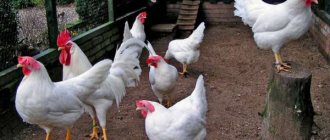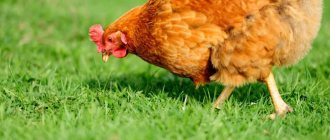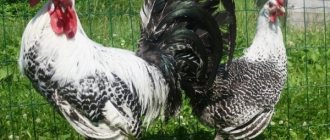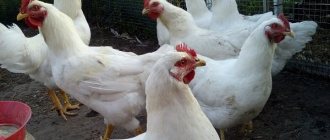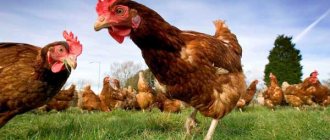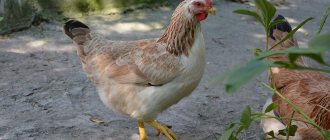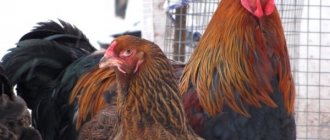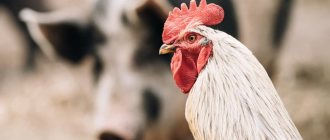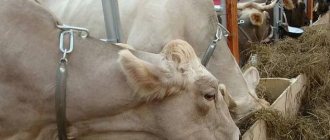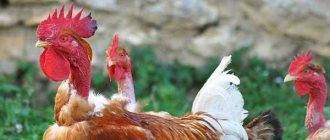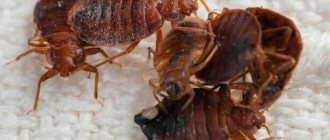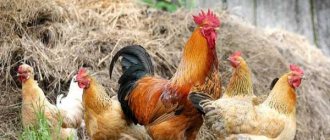Poultry farming » Chickens
0
1176
Article rating
Kira Stoletova
The Poltava clay breed of chickens is hardy, disease-resistant and has good meat and egg productivity. To obtain it, breeders crossed Poltava chickens with Wyandotte, Orpington and New Hampshire. How are these birds kept and bred?
Poltava clay chickens
Breed characteristics
Description of the appearance of Poltava chickens:
- head of medium size, rounded;
- the comb is rose-shaped, consists of numerous segments, in some birds it is leaf-shaped;
- earlobes and crest are scarlet with white splashes;
- eyes yellow-red or fiery tone;
- the beak is compact, pointed at the tip, yellow;
- neck, massive, strong;
- the frame is elongated, the chest is wide;
- the wings are medium in size and fit snugly to the body;
- legs are not too long, yellow in color;
- the plumage is light or dark brown, the tips of the feathers are black.
Productivity indicators
Adult females reach a weight of 2.2-2.5 kg, males - from 3 to 3.5 kg;
Egg production ranges from 180-200 eggs, the average weight of a cream-colored egg is 55-56 g.
Chicks of this breed have a good survival rate - 97%, yearlings - 90%. Fertility rate is from 80 to 83%.
Character
The Poltava clay breed of chickens has a friendly character. There are no conflicts or fights in the herd. Cockerels have a favorable attitude towards young animals and do not show aggression towards the owner and individuals with a different color. Therefore, joint keeping with representatives of other varieties is allowed.
It tolerates stress well and easily adapts to new conditions, so it is often transported to various regions of the country for further breeding.
Price
The average price for one hatching egg is 55-60 rubles, grown young eggs - from 300 to 350 rubles. You can purchase purebred chicks from the Sergiev Pasad Gene Fund.
Varieties
There are three lines of Poltava rock: clayey, black, zozulyasty.
The black subspecies is mainly bred in Poltava. There are only a few dozen representatives of this breed line, but breeders do not lose hope of increasing their number.
Zozulyasty Poltava chickens are also called cuckoo chickens. Chickens have beautiful plumage: a wide stripe of light color alternates with dark. They are lightweight. The species is on the verge of extinction.
Clay Poltava chickens are the main representatives of the breed; there is a large population. This species is common in Russia and the CIS countries.
Next, the characteristics of the clayey variety of rock are discussed in detail.
Advantages and disadvantages
Chickens live quietly in a confined space
The characteristics of the breed include several important advantages:
- excellent taste of meat and eggs;
- rapid weight gain and early egg production;
- peaceful character;
- good adaptive abilities - easily tolerate stressful situations when moving to another habitat or long-term transportation, without reducing productivity indicators;
- possibility of keeping without a walking area;
- high resistance to many diseases.
There is one drawback - a tendency to obesity, which leads to a decrease in egg production and a decrease in the number of hens. To avoid this, chickens need to be provided with a balanced diet with the addition of greens, calcium and a reduced amount of feed, especially if the birds are in captivity.
The appearance of babies
Small chicks hatch, golden or light brown - in clay ones. Black chicks hatch like this. Zosular cubs have a grayish color. The offspring are quite strong and hardy if you create optimal conditions for them.
Chicken diet
In the first week, the cubs should be fed the traditional food for this period - mashed boiled eggs mixed with semolina or fine corn grits. When 3 days have passed, you can add greens.
Experienced farmers recommend adding yogurt or other fermented milk products to children. Already ten-day-old babies can add ground shells for full development.
Breeding Features
To breed chickens of this breed within the tribe, you will need to carry out a strict selection of laying hens:
- the first culling at an early age - 1-2 weeks, the most active females are selected, without defects and pathologies;
- the second selection is carried out at 5 months and is determined by productivity indicators;
- Then they observe the behavior of the bird and its desire to incubate eggs.
Two-year-old individuals are suitable for breeding new offspring. Eggs are placed under the hen in late April or early May. After 20-21 days, the chicks hatch.
You can put 13-15 eggs under one individual. In the first week, it is important that the hen does not leave the eggs for too long, otherwise they will cool down and chicks will not hatch from them.
Many breeders believe that the natural method of breeding birds does not always produce effective results, so they resort to using an incubator.
Incubation
For laying in the incubator, select medium-sized eggs with a flat and smooth surface, without cracks. They should not be washed before installation.
All copies must be fresh - no older than 6 days. Select ones that are not too pointed or blunt, because... high probability of producing offspring with defects.
The deposited material is tightly closed in the chamber, and the temperature is set at 40°C. The eggs need to be turned over every day so that they warm up evenly. Every 7 days it is lowered by 1°C.
In the incubator, the chicks are born after 3 weeks.
Care
Basic rules for caring for chickens:
- hatched individuals are placed in a small cardboard box covered with straw, sawdust or a rag so that they dry faster;
- Additionally, an IR lamp is installed at a distance of 0.5 m from the box and kept on for at least 22 hours a day;
- the optimal temperature is 32°C, then every day it is gradually lowered and brought to 19°C;
- after 10 days, it is fashionable to release the young animals into the fresh air in the first half of the day, when the sun is shining - this will have a beneficial effect on their growth and health;
- At the age of one and a half months, grown-up chickens are transferred to a common flock.
Feeding
The diet depends on the age of the young:
- on the first day they offer a boiled and finely chopped chicken egg;
- from the third day, chopped onion feathers;
- at seven days of age, chicks can be given low-fat cottage cheese, small cereals, boiled grated carrots;
- after three weeks, chopped dandelions, nettles, plantain and clover are added to the food - these components normalize the functioning of the digestive system;
- powdered eggshells, meat and bone meal, fish oil, fermented milk, as well as grated fruits and vegetables are used as vitamins and minerals;
- The glucose solution gives strength, energy, and improves immunity, so it is recommended that the chicks be given water in the first days of life - 50 g is dissolved in a liter of water.
Young animals quickly gain weight and easily adapt to any living conditions if they are fed regularly and often - at least 6 times a day. At the age of 1.5 months, they are completely transferred to feeding adults.
Reproduction
To successfully replenish the population, Poltava clay breed can be bred at home. The optimal ratio in the herd is 8 hens to 1 rooster.
The birds are distinguished by excellent maternal instinct and diligently sit on the masonry. It is necessary to check the nests regularly, as there is a risk of eggs brooding, causing them to deteriorate.
One hen hatches up to 15 eggs. The female is fed well and ensured that she drinks on time. You should not let her leave the nest for more than 15-20 minutes a day.
Chicks of the clayey Poltava breed hatch in 21 days. It is better to start breeding in April and end in the fall, since in the warm season there is an abundance of succulent food.
The weight of the chicken is on average 40 g, the color of the down is light brown. With proper nutrition, the chick reaches a weight of 250 g in the fourth week.
Content Rules
It is necessary to constantly monitor the order in the chicken coop
The health, productivity and growth of the entire population depends on the correct habitat of the bird, its feeding and further care.
Poultry house
This breed is large in size, so it requires a lot of space - about 50 m³ per individual.
The chicken coop must be clean - it is cleared of debris, all surfaces are disinfected with lime or a solution of colloidal sulfur (2%).
To create a good microclimate, you need to insulate the floor - it is covered with tin or boards, covering all the cracks. Then a thick layer of bedding made of hay, straw or sawdust is laid on top. The laying is carried out on a dry and sunny day, otherwise the flooring will absorb moisture and quickly become moldy.
Low perches for chickens are installed near the walls - 0.5 m. Nests are also placed - 1 box for 4 laying hens. Choose a quiet place, with dim light, so that the bird can lay eggs calmly.
Feeders and drinkers are placed on the floor at a rate of 4 and 3.5 cm per individual, respectively. Place a wide basin filled with dry clay, ash or sand for taking dry baths. Regular procedures will help protect against the appearance of various parasites.
The optimal humidity level is no higher than 60%, so the room must have good ventilation - through windows or doors. Temperature in winter is 17-20°C, in summer - 12°C.
Diet
It is necessary to feed poultry with compound feed - purchased or home-made. To obtain a good composition, you need to mix several ingredients: minerals, sunflower meal, crushed wheat or oats, meat and bone meal or fish meal in a ratio of 1: 3: 4: 1. Consumption per individual - 130 g.
Depending on the time of year, they give different food.
- In winter, when there is a deficiency of vitamins and minerals, they are fed with grass flour, small pieces of cabbage, and beets. They give boiled, grated potatoes, carrots, but in limited quantities, because... this bird is prone to obesity. Dry mixtures include crushed corn, wheat, oats, and barley. Laying hens are given separate feeders with meat and bone or fish meal; fish oil, powdered egg shells, chalk, sprouted wheat, rye or barley are added to the food. All these components increase immunity and promote good productivity. Birds are also given vitamins and minerals during the off-season to prevent the occurrence of various infections.
- In the summer, they willingly eat shells and insects that they find in the yard. Additionally, they are offered fresh grass - dandelion, nettle, clover. Grated vegetables, fruits and root vegetables.
The herd needs to be fed twice a day - morning and evening.
Drinks must always be clean and fresh, so they are replaced every day. In winter, warm water is served at room temperature, in summer - cold.
Walking yard
For this breed, you need to try to arrange a place for walking, because... Due to lack of mobility, chickens quickly become fat. For one individual, 2-3 m³ is allocated.
At the beginning of spring, the yard is sowed with herbs so that the chickens have fresh greens all summer. The surface is sprinkled with gravel, small pieces of chalk, and shell rock.
To prevent birds from leaving the yard, it is necessary to make a fence about 1.5 m high. Cover the top with netting, and cover it with slate in winter. Under such a cover, chickens will be able to walk not only in the warm, but also in the cold season, pecking at the snow and looking for leftover food in it.
Molting and break in egg production
Usually this process occurs in the spring and is accompanied by the cessation of egg production. The duration of molting is from 2.5 to 3.5 months, after which the bird completely changes its plumage and restores its clutch.
For a quick recovery, the breeder should increase nutrition - increase the protein content in food and reduce the amount of calcium.
It is better to keep molting hens separately, because... bare skin can be injured during mating with roosters.
Egg production
Poltava clay chickens are in demand due to their early ripening.
The hen lays her first eggs at 20 weeks. In a year it turns out to be 200, in rare cases - 300 pieces.
The eggs are large, weight - 55 g. The shell is brown - a consequence of the work of the golden color gene. Thick and strong, contains a lot of calcium. Eggs have a predominant protein content, which makes them valuable for athletes building muscle mass.
Poltava chicken eggs have a high fertility rate of 83%. The survival rate of offspring is 100%.
The maximum peak of egg production is from 7 months to 1.5 years. They do not lay eggs during the molting period. By the fifth year of a bird’s life, it is reduced to 60% and it is unprofitable to keep laying hens any longer. Therefore, the livestock requires updating.
Possible diseases
These chickens have good resistance to many diseases, but in conditions of dampness, cold, microclimate disturbance and poor nutrition, their immunity decreases and the body is exposed to various diseases.
Often suffers from colds from hypothermia, and coccidiosis when kept in a dirty room. To avoid this, you should optimize care and comply with all sanitary and hygienic standards.
When overcrowding or microclimate disturbances occur in a musty chicken coop, birds may develop worms, mites, lice and lice. Their occurrence can be prevented by providing only clean and fresh food and eliminating contact with wild or neighboring birds that are carriers of parasites and diseases.
Also for prevention it is necessary:
- change the bedding once a year, disinfect the floor and walls;
- vaccinate early in life;
- examine birds for the presence of infections and parasites, and also move birds to quarantine in a timely manner;
- Provide clean drinking water and a balanced diet in accordance with age.
In day-old chicks, breeders note the development of various pathologies and defects; some are born stunted and die. The whole reason is the use of old, disease-infected and low-quality material. Therefore, when placing them in an incubator, it is necessary to follow the above described rules for selecting eggs.
When do chickens start laying eggs?
In birds, sexual dimorphism is widespread, which is primarily expressed in the size of the male and female. Usually the male is not much larger than the female, but in turkeys and muscovy ducks the male is 1.5-2 times larger than the female. There are very rare cases when the female is larger than the male (in quails).
Puberty of chickens occurs at the age of 150-170 days, depending on the breed of chickens. The egg production of laying hens is usually higher in the first year of laying. In the second year, the egg production of chickens decreases by 17-20% and ranges from 120 (for meat breeds) to 270 (for egg breeds of chickens) eggs per year.
Rooster tramples hen
The sexual activity of a rooster directly depends on its age. It is better if the rooster is between 1 and 4 years old - during this period it is best expressed. In some breeds of roosters, good sexual activity lasts up to 7 years. Usually one rooster is mated with 10 hens. But with an aviary (closed housing) and with good nutrition, the load on the rooster can be higher: 1 rooster for 17-20 hens.
Breeders reviews
Many owners give positive characteristics to this breed:
- Poltava chickens quickly begin to lay eggs, gain weight well and are not demanding in feed, which makes it possible to significantly save on their maintenance;
- some choose this breed because of its tasty and juicy meat, which, with a balanced diet, contains virtually no fat;
- many are attracted by the calm and peaceful nature of birds, which allows them to be kept with others;
- Many farmers are engaged in natural breeding of livestock, and the result is quite successful - a hen can breed 2-3 offspring per season.
History of the origin of the breed line
The breed owes its origin to several foreign and domestic laying hens; New Hampshire, Orpington, Wyandotte and local chickens took part in the selection. The first positive results were presented in the middle of the 19th century, but improvements are still being made.
The public became familiar with Poltava laying hens in 1895 at an exhibition of farm animals. It was then that experts paid attention to it, after which work was carried out to improve egg production, thanks to which two more varieties of the breed appeared. In total the line includes three types:
- Clay is the most common individual.
- Black - is on the same level as described above, but has a black feather color.
- Zozulistaya (Poltava calico) is a rare form that is found exclusively in private collections and has a cuckoo coloration.
A characteristic difference between all types is the color and level of performance.
Maternal instinct
Mother can be taken as an example to her relatives, because by nature she has excellent maternal qualities. Thanks to the developed brooding instinct, you can breed chicks without an incubator. For the birth of small, vocal chicks, the mother needs 21-22 days. Experienced poultry farmers recommend planting the hen in April-May. One mother is able to give her warmth to 14-15 testicles at a time.
Helpful advice:
- It is important to ensure that the mother sitting on the eggs always eats on time, especially at the beginning of the process. Hunger and thirst are the only motive that can make her give up her eggs and go in search of food.
What are the weak points?
- The Poltava breed of chickens does not control their appetite, which is why they often suffer from obesity, which reduces the duration of the productive period.
- With age, productivity gradually decreases.
That's all the information. Good luck and success to you!
Share the material on social networks - let your friends also learn the features of Poltava hens! Subscribe to site updates and you will always be the first to receive new, interesting information about feathered beauties!
Did you like our tips? Share with friends on social media. networks!
